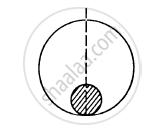Advertisements
Advertisements
प्रश्न
Particles of masses 2M, m and M are respectively at points A, B and C with AB = ½ (BC). m is much-much smaller than M and at time t = 0, they are all at rest (Figure). At subsequent times before any collision takes place ______.

विकल्प
m will remain at rest.
m will move towards M.
m will move towards 2M.
m will have oscillatory motion.
उत्तर
Particles of masses 2M, m and M are respectively at points A, B and C with AB = ½ (BC). m is much-much smaller than M and at time t = 0, they are all at rest (Figure). At subsequent times before any collision takes place m will move towards 2M..
Explanation:
The particle m at B will move towards A with the greater force, due to particle 2M at A.
Force on m at B due to 2M at A is
`F_(BA) = (G(m xx 2M))/(AB)^2` towards `BA`
Force on mass m at B due to mass M at C is
`F_(BC) = (G(M xx M))/(BC)^2` towards `BC`
Therefore, the resultant force on mass m at B due to masses M and 2M is
`F_"net" = F_(BA) - F_(BC)` .....(Because FBA and FBC are acting in opposite directions)
`F_"net" = (2GMm)/(AB)^2 - (GMm)/(BC)^2`
As `(BC) = 2AB`
⇒ `F_"net" = (2GMm)/(AB)^2 - (GMm)/(2AB)^2`
= `(2GMm)/(AB)^2 - (GMm)/(4(AB)^2`
= `(7GMm)/(4(AB)^2` (along BA)
Hence, m will move towards BA (i.e., 2M).
APPEARS IN
संबंधित प्रश्न
Write the formula to find the magnitude of the gravitational force between the earth and an object on the surface of the earth.
The earth and the moon are attracted to each other by gravitational force. Does the earth attract the moon with a force that is greater or smaller or the same as the force with which the moon attracts the earth? Why?
Write the three laws given by Kepler. How did they help Newton to arrive at the inverse square law of gravity?
Inside a uniform spherical shell
(a) the gravitational potential is zero
(b) the gravitational field is zero
(c) the gravitational potential is same everywhere
(d) the gravitational field is same everywhere
A solid sphere of mass m and radius r is placed inside a hollow thin spherical shell of mass M and radius R as shown in the following figure . A particle of mass m' is placed on the line joining the two centres at a distance x from the point of contact of the sphere and the shell. Find the magnitude of the resultant gravitational force on this particle due to the sphere and the shell if (a) r < x < 2r, (b) 2r < x < 2R and (c) x > 2R.

The gravitational field in a region is given by \[E = \left( 2 \overrightarrow{i} + 3 \overrightarrow{j} \right) N {kg}^{- 1}\] . Show that no work is done by the gravitational field when a particle is moved on the line 3y + 2x = 5.
[Hint : If a line y = mx + c makes angle θ with the X-axis, m = tan θ.]
Define one Newton. How much maximum acceleration can it produce in a mass of 1 kg?
Name and state the action and reaction in the following case:
A person walking on the ground.
Solve the following problem.
Calculate the acceleration due to gravity at a height of 300 km from the surface of the Earth. (M = 5.98 × 1024 kg, R = 6400 km).
Two particles of equal mass 'm' go around a circle of radius R under the action of their mutual gravitational attraction. The speed of each particle with respect to its centre of mass is ______.
